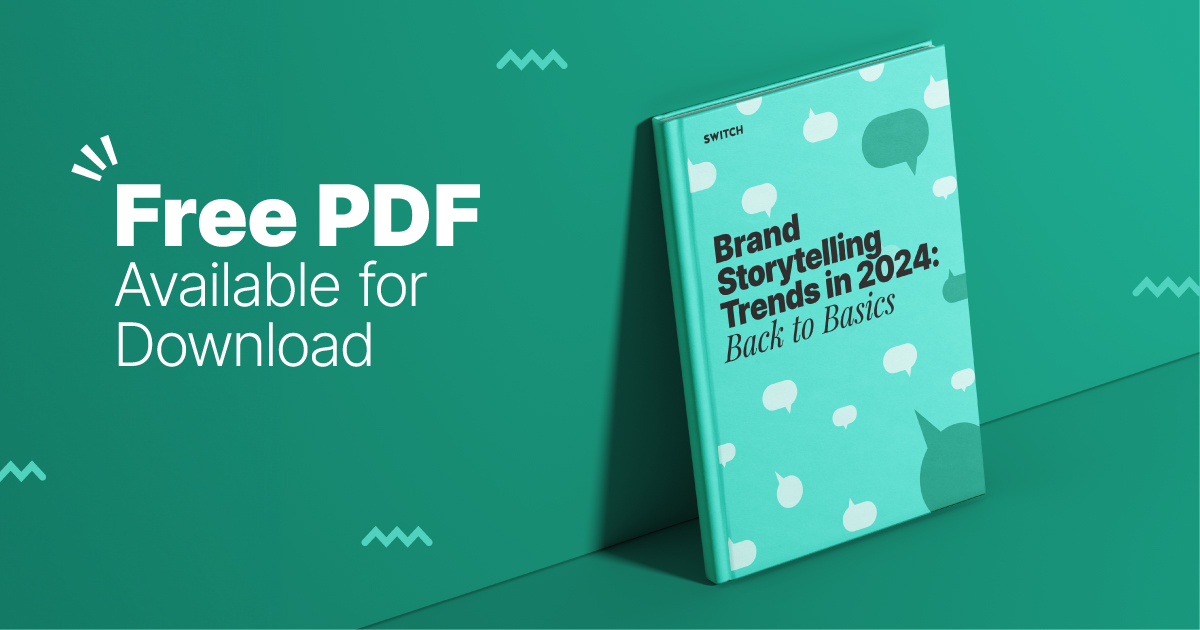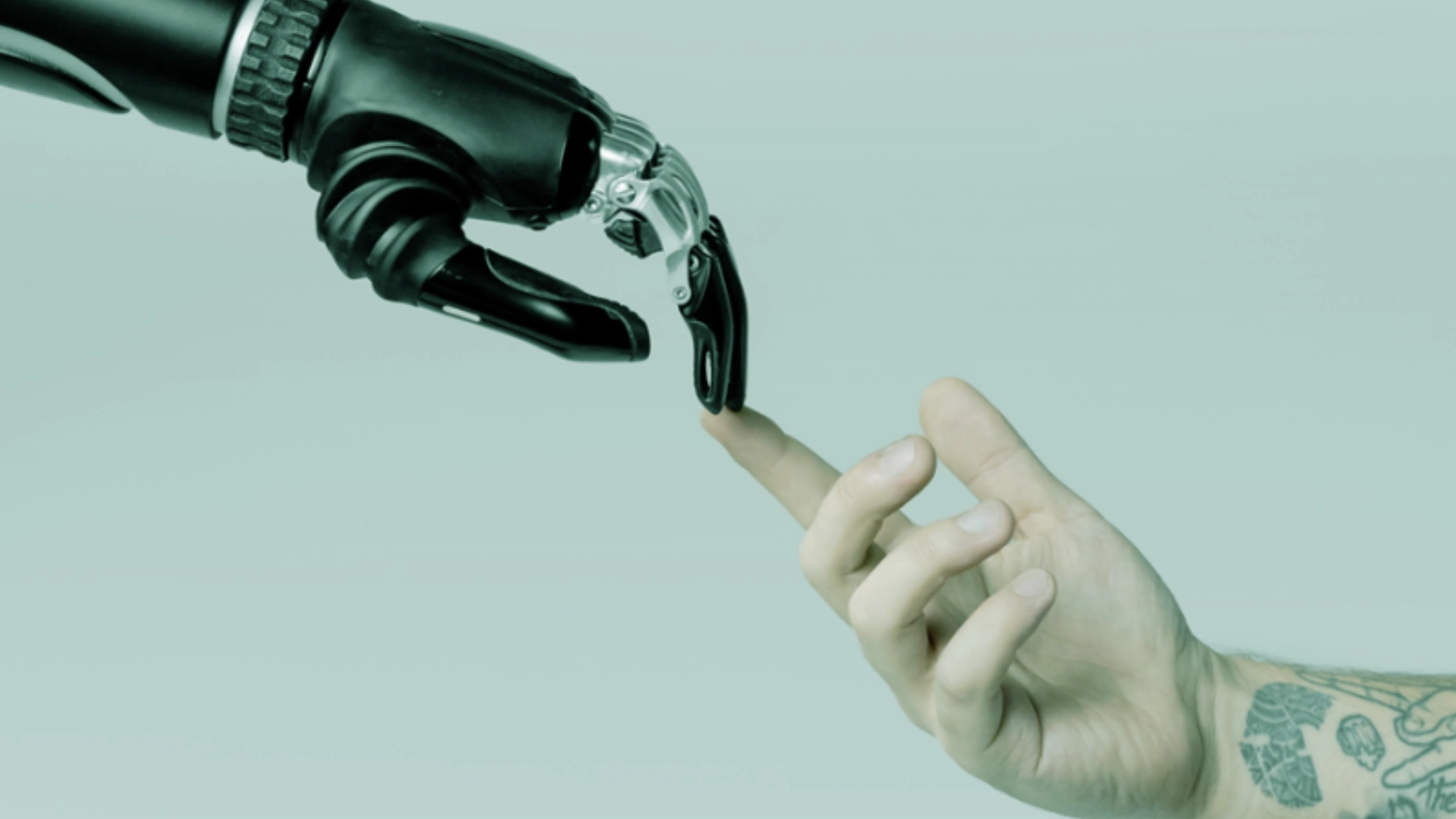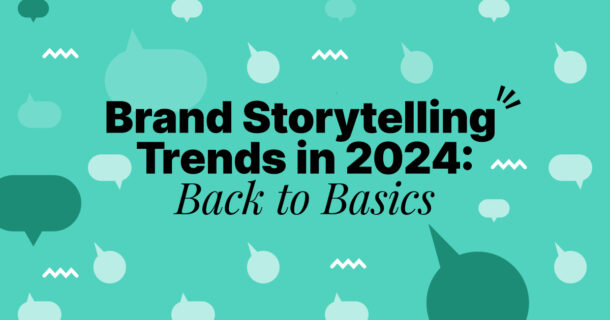Get a designed PDF copy of Brand Trends 2024
If you don’t have the time to read this article now, you can download the PDF version of Brand Storytelling Trends in 2024: Back to Basics for free by clicking below. Otherwise, just keep reading.


Narrative is the most human trait.
It defines us as a species – we are able to tell stories to each other with the intent of changing someone else’s mind. Without the ability to convey a narrative, we are just free-range monkeys.
Since it is that old, one may argue that narrative doesn’t change much – in essence it either tells us a story to motivate us (you will look great in this outfit) or to scare us (protect your business from cyberattack).
But the stories that surround us, the ones that get us to pay attention and eventually change our behaviours or beliefs, are the ones that are in tune with what’s going on around us.
The word on the street, the zeitgeist, the meme du jour, the trending tweets (fuck X), this hour’s TikTok dance… while these might all fit within the structure of a core narrative, they speak to us about what’s going on right now.
And we live right now.
As 2023 comes to a close, here’s a look at the narrative trends that could shape 2024.
After all, a year is just a collection of the stories that it leaves behind.
As always, strong narratives will win the game.
When the ‘noise’ gets louder, as audiences are bombarded by even more messages from even more sources, it is the strong stories that will stand out.
Think of it as signal-to-noise ratio. Our stories need to be a strong signal if they are to stand out from the noise.
And it isn’t just about the narrative. It’s about how that narrative gets to where it needs to be. It’s about how that story lives in whatever medium it is told in.

Audience-driven insights
There are three underpinning insights that will most likely dominate narrative trends in 2024.
The general frustration in a post-truth era.
Not knowing what narrative is true, having stories that reach us devoid of crucial context, and faced by an overwhelming stream of contradictory information, audiences will respond positively to anything that appears unequivocal. This is further complicated by the era of generative AI. As audiences are exposed to more content that’s generated by minds made of silicon, their ability to discern what’s real, what’s human, and what’s been made up by machines continues to sow doubt.
Lack of time, lack of interest
Consumers oscillate between being very busy or being bored – both states welcoming brevity over depth. While this has plenty to do with the behavioural shift towards doomscrolling, it still favours concise storytelling that grabs attention.
Data privacy determinism
Finally, there is the reluctance of audiences to go on trading large amounts of information about themselves in exchange for products such as social networks. This trend is, for now, on the fringe compared to the other two but it will have consequences on the way we tell our stories.

Market-driven insights
Particularly in B2B marketing, more marketers are citing a lack of resources as their major stumbling block. With an ever-expanding set of tools at our disposal, the spectre of a recession, and narrower margins almost across the board, this comes as no surprise.
There has also been a steady rise in the use of paid media. While smart content marketing and first-party data strategies reduce the dependency on paid media, a surprising number of marketers admit to operating without at least a 12-month plan, let alone a strategy for sustainable communication.
On the other side is the ubiquity of artificial intelligence, giving small marketing teams the tools they need to punch well above their weight, saving money on content writing, planning, and even the need for additional human resources. This is a big thing – AI has become part of the marketing tech stack within a shorter timeframe than any technology has.
This time last year we weren’t speaking about AI unless it was in very specific and very tech-oriented spaces. This year, 3 out of 4 of those working in B2B marketing say that they use at least one AI tool at work.
As resources appear to shrink and new tools emerge to help the industry do more with less, we should be seeing briefer, more punchy pieces of content that, happily, suit the ever-shrinking amount of time audiences are willing to give up.
On top of this is the sheer volume of data that is available to anyone who wants to communicate. Narratives that are driven by data will be the ones that reach their target with the highest degree of precision, winning on cost-effectiveness and efficacy.

Narrative Trends in 2024
Trend 1: Inter-ACT
- Interactive content saw 52.6% more engagement than static content
- 52% of marketers find interactive emails as the most effective form of marketing.
- 88% of marketers see interactive content as a way to differentiate themselves
The data is clear on this and it isn’t surprising. In an era where most of our distribution platforms are interactive, there is little reason to produce static content, particularly when interactive content sees over 50% more engagement than static content.
The same applies to interactive emails, with over half of marketers experiencing more engagement from interactive emails than static ones.
What is surprising about this trend is that it sounds obvious and yet marketers seem reluctant to go the extra mile and think in terms of interactivity. Broadcast media like TV and radio had a good run that lasted decades but their time as dominant players is over. Thinking like broadcast is the only method of reaching an audience is to remain stuck in a time when today’s tools aren’t available.
You’ve seen influencers try their hand at interactivity: “What’s your favourite ice-cream flavour?” As simple as this sounds, it is an invitation to interaction with the lowest barrier to engagement possible.
Let’s learn from this practice (but implement it better) by thinking of friction. If we produce interactive content, we must give audiences the pathway to reach out that has the least friction possible. Let us make it easy and interesting for our audiences to interact and be sure to offer a good reason (read ‘reward’) for them to reach out.
In a sea of one-way comms, interactive content is a chief differentiating factor. It tells your audiences that you’re up for conversation and, done well, it tells them what kind of chat you’d be happy to have. It turns your brand into that person we’d meet for a coffee, knowing a good conversation is to be had.
And that’s the start of a friendship right there.

Trend 2: Authentically Human
- 51% of marketers consider differentiating their content the biggest challenge with the rise of AI tools.
- 54% find the amount of content available overwhelming, but find the quality lacking
- 31% of marketers find AI-generated content quality to be lacking
During the time when fast-food restaurants were on the rise, traditional restaurants tried to differentiate themselves by writing ‘home-made lasagna’ on their menu boards.
We knew it wasn’t true but we willingly bought into the distinction.
As AI-generated content improves in its coherence and quality, it is becoming harder to tell what’s been made by a person and what’s been generated by an AI. Meta has launched a series of AI influencers, each able to interact with millions of humans at the same time without missing a beat.
The chances are that a third of the content you’ve read today has been, at least in part, created by an inanimate device. And this is set to increase as more and more of the workforce climbs over the perception hurdles and adopts this tech in some form or another.
The result is that there will be more efforts to distinguish AI-made content from human-made content.
And content that can be verifiably created by a human will score points for authenticity.
This is not to say there is anything wrong with machine-made content. It is simply an echo of the way humanity reacts to new technologies. When every leather handbag was stitched by a human hand, there was little to distinguish one from the other. Now that machines stitch most bags, the handmade becomes more valuable.
This blog was written entirely by a pair of human hands and a kitten’s paws sfl,,,,,. Bv jik eeeerrrrttt


Trend 3: Brevity is the soul
- 94% of marketers agree that short articles is the most popular form of content
- 95% of all content distribution happens on social media
- 47% of marketers put all their content in images
We are all competing for attention all the time. We are also afflicted by an epidemic of ever-decreasing attention spans.
This ushers the era of short headline-style content that conveys as much information as possible in as short a consumption moment as possible. By ‘headline-style’ we mean any form of content that one can consume in a very short time. Memes, gifs, zero-click content, images, and short videos all qualify.
What about long-form content? Longer reads, in-depth podcasts, long-form video, and other forms of narrative that are involving or longer to consume still have their place in telling a complete story.
We just need to lead to them with a much shorter hook.
This should not be an issue for content creators. It is good practice to find the shortest possible way to convey a message while retaining clarity and all necessary information. As the trend towards brevity gains more traction, cunning storytellers will find new ways of telling short-form narratives.
Ultra-short form, the blink-and-you’ll-miss-it form of content, is something of a novelty in mainstream comms but it has been quite standard in niche and closed-group circles, especially those composed exclusively of Gen Z and younger individuals. The move from niche to mainstream is inevitable and we will see more content that’s ultra-brief, usually depending on a link to an established narrative that we, the audience, are already aware of. Think of this kind of content as a mass-appeal in-joke.
Another useful angle to this trend is the creation of micro-moments within longer narratives. These serve as little breaks, giving our audiences a short reprieve from longer form content in the shape of a snack-sized piece of content that’s there to distract for a moment. Micro-moments can be informative, entertaining, or even a simple change in content delivery method (like a 5 second video within a blog post) and that help keep our audiences engaged for a little longer as they skip down the path of your defined user journey.
In essence, however, brevity is an ever-appreciating commodity:
- Scrap useless words (or scrap words completely)
- Lead with a benefit
- Consider the appropriate platform
- Link to a wider story
- Grab attention in 5 seconds or less

Trend 4: Data destiny
- Data storytelling has increased by 233%.
- 93% agree that data storytelling boosts revenue.
- Consumers are 63% more likely to remember data if it’s presented as a story.
We’ve had accurate and real-time consumer data available to us for decades now. We’re used to data feeding into accurate targeting, consumer insights, and campaign optimisation, to mention just a few ways in which data carves the messaging we create. But having much more data available to us is not enough to form an emerging trend.
The trend is being shaped by data storytelling itself. Presenting data alone isn’t enough. There is no story to a statement that says “62% of consumers prefer this drink to its competitor”. A story alone is interesting but it is much more captivating when backed up by real numbers. And this is the basis of data storytelling – the way we can use data as a component of an engaging narrative.
Over the past 5 years, data storytelling has grown by 233%. Which forms the shape of a gentle trend but this is set to grow significantly next year as the technology that’s available to us boosts this trend from multiple angles.
The intelligence that was needed to properly harness data for storytelling purposes was reserved for companies with deep enough pockets to afford powerful Business Intelligence and market research capabilities. As AI services become affordable to all, the ability to spot behavioural patterns in huge datasets reaches the masses.
Tugging this trend from a completely different angle, but pulling it in the same direction, is the ever-increasing epistemological crisis – we simply don’t know what the truth is any more. Data-driven storytelling is one way to let the market know that what you’re saying is rooted in an unquestionable truth.
Another way of looking at this trend is a shift of narrative from the ‘what’ to the ‘why’, particularly in the case of B2B narratives. It takes us from “this is what people do with this product” to “this is why people change their minds and here is the data to prove it”.
Finally, there is much to do with the way our brains are wired. While we tend to understand the numbers, we don’t remember them. We are 22 times more likely to recall a story than numbers alone. The linking of story and data is a combination that bends credibility with memorability and it is this confluence that will create powerful narratives going into 2024.

There’s more
The trends that have been shaping up over the past few years are digging in deeper and turning from trends into mainstays of commercial narrative.
The desire for authenticity and transparency isn’t going anywhere. If anything, it is being reinforced by the difficulty our audiences experience with being certain about what is real. Deep fakes, AI personalities, the distorted narratives around politicised events, and all other forces that distort the stories that describe our world raise more questions than they answer. Demonstrable authenticity, aided by data-driven storytelling, will form the mainstays of the stories that matter.
This demand for authenticity will favour human-led narratives and put even more value on the local and the hyperlocal. The closer to home a story appears to be, the more likely we believe it to be authentic and relatable.
In the same vein, the humanity of our narratives, the ability of our content to be consistent with who the organisation is, what it stands for, and how it is different from all others, will be the currency by which the greatest stories are measured.
Finally, we remain ever hopeful that this will be the year of A/V/XR, the year when the market finally sees excellent VR hardware at mass-market pricing, paving the way for truly immersive content. Apple’s launch of their high end device is little more than a proof of concept and was aimed at studios and content developers but a launch of this nature usually portends a shift towards a more widely accessible product. When it happens, a third dimension will really be added to the content we produce and consume.

2024 the year of human lore
The art of storytelling won’t suddenly become more important in 2024. It has always been the way we stood out from the rest of the animals on earth and will continue to do so.
But there are trends that will define the year and they will be greatly influenced by the tools we have at our disposal and the general behavioural patterns of the market.
More than ever before, stories backed by facts and figures in a post-truth world will win on authenticity. We do have more data available to us. Let’s use it wisely to reach the right people with the right message.
The right message is never noise – it feels personal and stands out from the rest of what’s being said by appealing to us in a way that’s respectful of our time (brevity), of our intellect (clearly useful to us), and of our identity (a match in fundamental values).
The right message is also one that honestly promotes diversity, equity, and inclusiveness (DE&I). While this was a brand trend a few years ago, it has gone from the fringe to the boardroom and that will strongly influence the narrative of 2024.
And while this is nothing new, we must endeavour to differentiate by telling a unique story. It seems like one out of every two pieces of content is a repost from another channel. And half of that again is a poor rehash of a trending topic. In a sea of sameness, the original will stand out.
Keep it short. Keep it relevant. Keep it human. Keep it unique.





